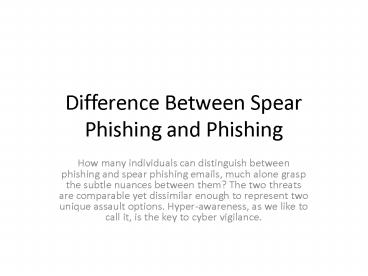Difference Between Spear Phishing and Phishing - PowerPoint PPT Presentation
Title:
Difference Between Spear Phishing and Phishing
Description:
How many individuals can distinguish between phishing and spear phishing emails, much alone grasp the subtle nuances between them? The two threats are comparable yet dissimilar enough to represent two unique assault options. Hyper-awareness, as we like to call it, is the key to cyber vigilance. – PowerPoint PPT presentation
Number of Views:66
Title: Difference Between Spear Phishing and Phishing
1
Difference Between Spear Phishing and Phishing
- How many individuals can distinguish between
phishing and spear phishing emails, much alone
grasp the subtle nuances between them? The two
threats are comparable yet dissimilar enough to
represent two unique assault options.
Hyper-awareness, as we like to call it, is the
key to cyber vigilance.
2
Spear Phishing vs. Phishing
- The primary distinction between spear phishing
and phishing is the method utilized by hackers to
carry out illicit behavior. Spear phishing is a
type of phishing that is targeted and customized
to a certain person, group, or organization.
Regular phishing emails, on the other hand,
employ a broad-brush strategy that entails
sending bulk emails to large databases of unwary
contacts. - Regular phishing emails are frequently hastily
prepared and typically do not include any
personal information about the receiver. Spear
phishing can be much more harmful than regular
phishing because of its hyper-targeted nature. A
spear-phishing message's familiar tone and
content make it difficult for the ordinary user
to notice hints of scam, raising the threat level
of this sort of cyber assault.
3
How to analyze and mitigate Spear Phishing and
Phishing Attacks?
- Because they aren't personalized (and terrible
language can be a dead giveaway), mass phishing
communications are frequently discovered and
deleted by end users. However, it is still true
that many less-vigilant individuals are still
susceptible to clicking on phishing email
attachments or links and failing to check a
sender's address before answering. As a result,
security awareness training and phishing
simulations are critical for reinforcing
fundamental concepts associated with recognizing
and preventing phishing threats. - Spear phishing is a considerably more complex
and developed cyber threat than the "spray and
pray" strategy of bulk email phishing.
Cybercriminals are successful in this sort of
targeted assault because spear-phishing
communications appear credible owing to the
inclusion of customized information about the
victim, such as contact information, hobbies, or
interests. - Furthermore, spear phishing emails are more
persuasively constructed than traditional
phishing emails. The message's content is framed
to appear to be from someone the receiver knows
or trusts. As a result, using an urgent tone is
far more difficult to resist, encouraging the
victim to act out of fear of a significant
financial loss, legal charges, or account
closure. - These well-written email messages frequently
contain links to bogus websites or attachments
containing malware, ransomware, or spyware. In
some situations, there are no attachments or
dangerous links, only instructions for the
receiver to follow, making them even more
difficult to detect using email security filters.
4
Why is Spear Phishing a rising threat?
- The detection difficulty level of spear phishing,
along with the development of remote workforces
and weaker technical measures, has made it a
method of choice for cybercriminals worldwide. - Successful spear phishing accounts for 95 of
all business network intrusions. - A spear-phishing assault may involve an email
that seemingly originates from the victim's bank
or a legitimate firm such as Amazon. The message
may appear to be a shipment notification or a
request for transaction confirmation, luring the
reader to click on a malicious link or provide
confidential personal information. - Cybercriminals also target businesses in this
manner, frequently focusing on a few employees at
a specific organization. A legitimate-looking
email, purporting to be from their manager or a
corporate official, may be sent, instructing the
unsuspecting employee or user to transfer money,
expose a password, or provide secret company
information. - A spear-phishing email usually conveys a sense
of urgency in both circumstances mentioned above.
It gives victims the feeling that if quick action
is not taken, they will suffer terrible
repercussions.
5
How can Email Authentication help?
- Having a strong email security plan in place that
integrates SPF, DKIM, and DMARC is crucial in
establishing key standards and barriers for
online communications as well as combating sender
fraud and spoofing, tactics utilized in the bulk
of current cyber assaults. - It is critical to remember that protecting your
business emails from today's sophisticated
attacks necessitates a defense-in-depth approach.
Email authentication protocols should be
implemented as part of a comprehensive strategy
to protect business emails, preferably managed by
a reputable email security provider like
EmailAuth. - We at EmailAuth provide full email
authentication services including DMARC, DKIM,
SPF, and BIMI, and other authentication
protocols. You can check out the EmailAuth
website for more details.































